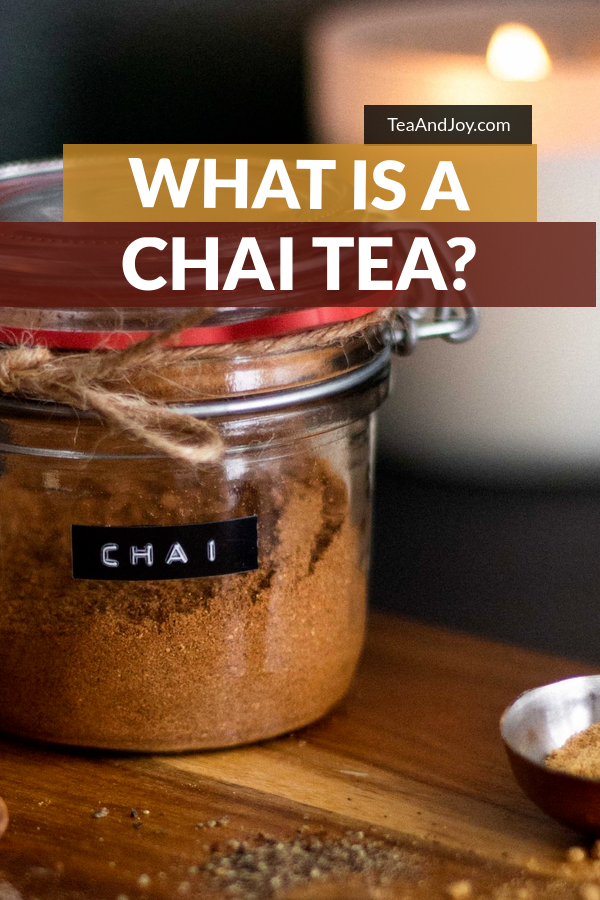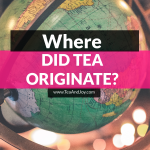Historically, chai tea was water and milk mixed with spices. With the British colonization of India though, black tea leaves were added to chai – this is the common form most of us are familiar with now.
Most often, you get to see an extensive array of options and flavors that can either elevate its traditional taste or make a whole new drink of itself. For a traditionalist, this isn’t ideal of course, but having options is always nice in my book.
What makes me love it is the soothing aroma and rich flavor – it’s calm and happiness in a cup.
For over centuries, many people from South Asian countries have also been indulging themselves in chai tea, whether for its irresistible taste or health benefits – yes, many people believe it’s good for you!
In this article you'll find:
What makes it special?
If you really want to understand something, you need to dig in and learn what makes it so distinguished from the rest of the beverages common all over the world.
Where it originated
Let’s first dive into the history. Its origin dates back to 5,000 years ago when an Indian king decided to use an Ayurveda creation called “chai” to heal minor issues in the body. Ayurveda is a traditional medicinal practice that is used in India. It uses natural herbs and spices to combat illness of any sort.
The ingredients used, like cloves, black pepper, and cardamon, along with many others, were highly prized by local citizens, mainly because of their enticing taste and exceptional healing powers.
Today
Nowadays, as the recipes and people evolve, you get to see it in its most versatile form. In fact, it’s quite hard to find two neighborhoods following the same recipe and methods of making it!
5000 years ago it used to be that it was only found in local Ayurveda stores. Now it’s spread dramatically across the globe through large-chain coffee shops and authentic south Asian restaurants.
For many people, it was non-existent until Starbucks introduced their Chai Tea Latte in 1998. A tea named in another language? The curiosity spread its name like wildfire. Many other companies like Nestle started producing chai tea latte coffee capsules, and bloggers began praising it for its outstanding aroma and versatility.
Basically, curiosity got people to try it, and the taste kept them drinking it. Not surprising for a drink that’s been around for 5000 years – I mean, it must be delicious!
So, What Does “Chai Tea” Mean?
I had to laugh when I found out. I think most of the people out there would guess chai refers to a tea made with a mixture of spices – and I guess it does, but that’s not the translation.
Chai comes from the Persian word “chay,” which originated from the Chinese word for tea – chai simply means tea. So when people say chai tea, they’re literally saying ” Tea Tea” but in two different languages.
As for Starbucks, putting the word “Tea” after chai was likely only for marketing purposes to help people understand it’s actually a form of tea.
So, it makes sense that Starbucks stuck to Chai Tea Latte’s title, which literally translates to ” Tea Tea Milk” since Latte is milk in Italian. How funny is that?!
Masala chai
While I’m sharing facts, let’s talk about what we people are really referring to when they say chai tea. In the U.S, its really masala chai made with a mixture of loose tea leaves and spices to get its bold taste.
What Does Chai Tea Have In It?
Anything that is chai-flavored mainly revolves around the dominant taste of cardamom. Its instantly sharp and musky favor can make any beverage or food item taste like chai.
Although the recipe and what really goes into making it differs from different regions, climates, and cultural preferences, the main ingredients stay relatively the same.
For instance, the traditional people in Kashmir use green tea and crushed almonds in chai instead of black tea, which Indians use to give a rather intense favor. Likewise, people in Bhopal use a pinch of salt in the chai to neutralize the sweetness.
That said, keep in mind that even minor variations can ultimately elevate or ruin the taste when it comes to chai, so keep that in mind as you experiment.
There are 4 basic categories that make up Chai
Masalas: depending on individual preference, these spices can include nutmeg, vanilla, cinnamon, cacao, cardamom, saffron, black peppercorns, ginger, cloves, bay leaf, allspice, star anise, and lastly cumin and coriander to add an extra layer of taste to its already rich flavor.
Sweetener: although many people prefer to go without sweetener, there’s no harm in adding sweeteners. And you have lots of options:
- White sugar
- Jaggery, which is unrefined cane sugar
- Coconut
- Demerara
- Turbinado
- Brown sugar
Tea leaves: the most popular kinds are the Assam and Darjeeling black teas in India. You can also use a mixture of South African herb red rooibos or English green tea to make it. Again, lots of options to try.
Milk: the traditional way used pure buffalo milk. However, the Western version has adopted other milk variations like cow’s milk, soy, almond, rice, and coconut milk to give your desired taste. Some people also find yak or goat milk to spice up the usual taste of the chai.
Buying ready-made spice mixes vs making your own
Although you can get these spices neatly packed in jars and ready to go, they’re pretty pricy and likely not as fresh/good as a mix you could make for yourself. Plus, you can experiment with different combinations if you buy the spices separately.
When purchasing, try to go for bulk purchases of cumin seed, big packets of cardamom and cinnamon, and black peppercorns. Since you can also cook with these spices, they can serve a double purpose!
As for making tea, you can mix up all the ingredients into a jar and only use it for tea or you can leave them separate, like I mentioned above, and try different blends and use them for cooking.
But, once you have a mix you like, preparing it ahead or in bulk can save you a lot of time. It makes the whole process pretty effortless since everything will be ready to go.
All in all, the concept of “what exactly is chai” isn’t black and white. Everything depends on different households and cultures. Since it has spread across the Western region, you can see more diverse options and ingredients.
Chai Tea vs. Chai Latte vs. Green Tea – The Differences
There is a significant difference between these three tea types. Chai tea is mainly loose-leaf teas brewed in hot milk and water and some spices and sweeteners to enhance the taste.
In comparison, chai tea latte is often made with soluble powder or flavored syrup. And you’ll usually find chai tea latte to be sweeter than chai tea.
As for green tea, it uses the same leaves as the others, but the similarities end there. Where green tea is all about unprocessed natural tea leaves in their original form, chai tea revolves around more oxidized and other well-known chai spices like cloves, cinnamon, and cardamon.
How to Make Chai Tea
There are a few ways you can make chai tea.
First is the ordinary, less intense version that takes minimum effort and time. In a saucepan add water, milk, tea leaves, spices and sweetener and bring to a simmer.
Second goes the extra mile with letitng the water and spices soak overnight. In the morning you can add your tea and milk and simmer it before pouring into your cup – using a strainer of course.
With either version you can play with any species you want, from cardamon to ginger to… well, you name it, and make your own scrumptious flavor.
Another method you can try is to go full-on with the traditional.
If that’s what you’re looking for, make sure you use the following:
- 1/2 cup milk
- 1/2 cup water
- 1 piece of star anise
- 1 peppercorn
- 1 clove
- 1/2 teaspoon loose black leaves
- 1-2 slices fresh ginger
- 1-inch cinnamon stick
- 2-4 whole green cardamom pods
- Optional – sweetener
Roast the peppercorns, cloves, star anise, and cinnamon for 2 minutes and set it aside to let it cool. Once cooled, use a coffee grinder to grind the spices into a coarse powder.
Once you are sure your powdered spices are ready, take a saucepan and add water, ginger, and powdered spices to bring them to a simmer. Remember, you don’t want to boil it since it will only make them taste bitter.
After that, simmer it for another minute. Then turn off the heat and pour into your cup through a fine-mesh sieve and discard the tea leaves or other waste that you may have.
If you think it needs some sweetness, you can always add honey, maple syrup, or sugar to make up for that.
This makes a masala chai, but some people prefer a recipe with only 3 or 4 main ingredients. For instance:
- Saffron chai mainly involves saffron, cardamon, and cinnamon
- Cardamon chai has cardamom and tea leaves
- Ginger chai is all about black pepper, milk, tea leaves, and ginger
What Makes Chai Tea Spicy?
Considering the number of spices that I mentioned above, I’m sure you’ve already guessed what makes chai tea spicy – it’s the black pepper and ginger that bring you that beautiful kick.
Buying and Storing
A bad quality tea blend can quickly ruin all the hard work to prep the tea. Although by poorly storing the tea, its leaves never go “bad,” it can get stale. Therefore, make sure to get your ingredients from reputable companies that can tell you how the chai was processed and what you can do to keep it in good condition.
Keep in mind you don’t want to store it near the coffee, or other strong-flavored powders, as it can easily leach the flavor into the tea leaves.
Besides that, here is a complete list of things to keep in mind:
- Never store your tea in the refrigerator
- Keep it away from sunlight and store it in an airtight container
- Store your sweetened and unsweetened teas separately
Conclusion
I hope you found this guide helpful. The great news is, there are a lot of different ways to answer the question. You can go traditional or modern; you can make your own version at home by experimenting with different spices, tea powder, and milk, or you can buy premixed versions.
Have fun and give it a go. The sky’s the limit with this one!




